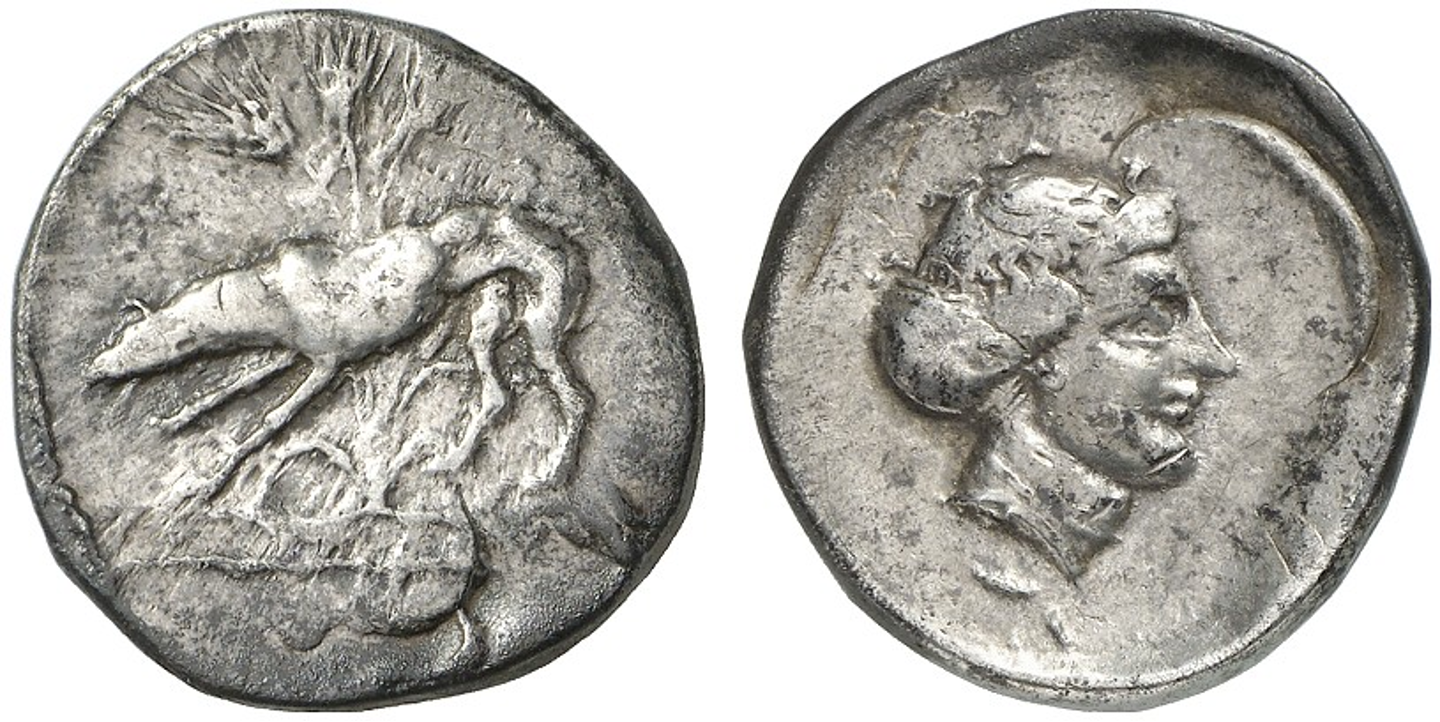412 BCE - 400 BCE | ΣΕΓΕΣΤΑZIB
Overstriking coin
SO 118 - Segesta (AR didrachm) over Corinth.png
[1]
Overstruck variety
Corinth Athena incuse square.jpeg
[2]
|
|
Sale(s)Sale(s) ᵖ:
|
Gorny & Mosch, 215, 14 Oct. 2013, 683.
|
|
|
|
Description
| ObverseInscription or printing placed on the obverse.:
|
Hound left. In the background, three grain ears.
|
ReverseInscription or printing placed on the reverse.:
|
ΣΕΓΕΣΤΑZIB (Greek) Head of nymph Aigiste right, wearing sphendone.
|
Mint and issuing power
| MintIdentifies the place of manufacture or issue of a numismatic object.:
|
Segesta
|
Ancient regionAncient region.
|
Sicily
|
Modern countryModern country: Italy
|
AuthorityIdentifies the issuing power. The authority can be "pretended" when the name or the portrait of X is on the coin but he/she was not the issuing power. It can also be "uncertain" when there is no mention of X on the coin but he/she was the issuing power according to the historical sources:
|
|
Chronology
| FromIdentifies the initial date in a range assigned in a numismatic context. 412 BCE toIdentifies the final date in a range assigned in a numismatic context.. 400 BCE
|
Classical 480-323 BC  periodTime period of the numismatic object. periodTime period of the numismatic object.
|
Physical description
MetalThe physical material (usually metal) from which an object is made.: Silver 
|
WeightWeight of the numismatic object (in grams). in grams: 8.438.43 g <br />8,430 mg <br />
|
DenominationTerm indicating the value of a numismatic object. Examples: tetradrachm, chalkous, denarius.: didrachm 
|
|
|
|
StandardStandard.: Attic
|
References
Description
| ObverseInscription or printing placed on the obverse.:
|
Head of Athena, wearing a Corinthian helmet, within incuse square (visible on reverse)
|
ReverseInscription or printing placed on the reverse.:
|
Pegasus (visible on obverse)
|
Mint and issuing power
| MintIdentifies the place of manufacture or issue of a numismatic object. ᵖ:
|
Corinth
|
Ancient regionAncient region. ᵖ
|
Peloponnesus
|
Modern countryModern country: Greece
|
AuthorityIdentifies the authority in whose name (explicitly or implicitly) a numismatic object was issued. ᵖ:
|
|
Chronology
| FromIdentifies the initial date in a range assigned in a numismatic context. toIdentifies the final date in a range assigned in a numismatic context..
|
periodTime period of the numismatic object.
|
Physical description
| DenominationTerm indicating the value of a numismatic object. Examples: tetradrachm, chalkous, denarius. ᵖ:
|
didrachm 
|
|
|
References

